
This article was originally published in the Vol. 25 No. 2 / Fall-Winter 2018 issue of West 86th.
This essay explores the significance of a corpus of square-based, mold-blown, and gilded glass vessels that were made in India in the seventeenth and eighteenth centuries and have been cast under the wider rubric of “Mughal glass.” By connecting these decorated flasks to similar containers made of porcelain in Japan, we may understand the key role that they played as gifts, filled with aromatic oils, packaged in custom-made boxes, and delivered to high-profile recipients around the Indian Ocean. Rather than isolated items of decorative interest, these highly mobile, much-dispersed, and valuable gifts of glass and porcelain composed parts of assemblages that were deployed strategically across the extended commercial networks of the Dutch overseas empire.
In the collection of the Corning Museum of Glass, there is a small wooden box subdivided into four equal sections, each fitted snugly with a glass bottle, and a brass funnel deposited in the center (fig. 1). Each bottle replicates the same shape, with a square bottom, sloping shoulders, a narrow neck, and an everted rim, topped with a brass stopper (fig. 2). The glass is uncolored but cloudy, and the surfaces are painted in enamel and gold. Each bottle follows the same decorative program, with figural scenes on two of the opposing sides and flowering plants on the remaining two. Each side is bordered by a decorative arched frame in gold. Thousands of miles away from upstate New York, in the collection of the Asian Civilisations Museum (ACM) in Singapore, a larger wooden box, with a ridged lid and silver fittings, holds six clear glass bottles, also angular in profile but with cylindric necks and slightly taller sides that are gilded with continuous floral patterns (fig. 3). Although the Corning box may have been replaced in the nineteenth century, after its bottles were made, the ACM box and almost all its bottles date to the eighteenth century.1
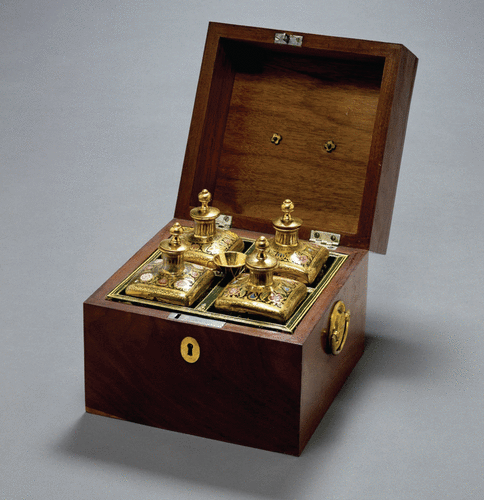
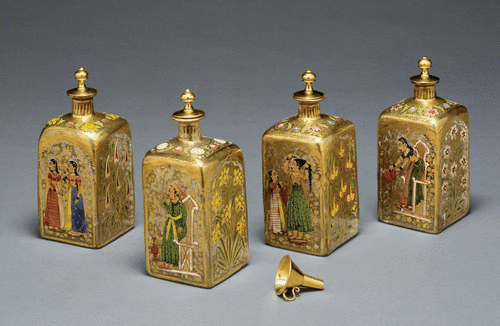
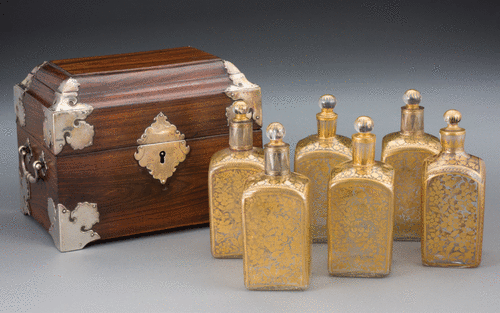
Together, these two boxes2 and their contents provide a useful reference point for a broader corpus of glass bottles that were originally produced in sets3 and probably also boxed,4 but have become detached from their associated mates and containers (see figs. 4, 5). All these glass bottles, whether boxed or independent, are linked by a number of consistent features: an angular base, flat sides, and gilded ornament, as well as the method of manufacture, having been made using triangular molds. The joints at the two corners where the mold segments were fused are invisible under layers of gilding, although the corresponding diagonal seam appears prominently on the base, punctuated by a pontil mark (fig. 6). These shared characteristics tie together a whole group of vessels of various sizes (ranging from two to seven inches in height5), glass colors (colorless, blue, yellow, green, and purple), shapes (square- or oblong-sided), and decorative programs (figural or floral) that can be found across museum collections in Europe, the United States, the Middle East, and Asia (see fig. 7).
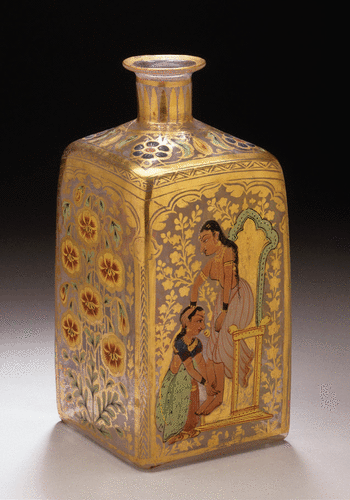
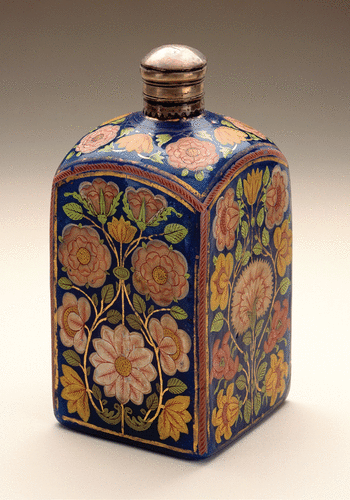
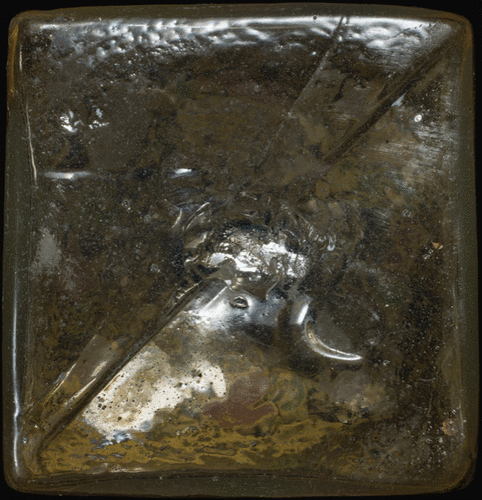
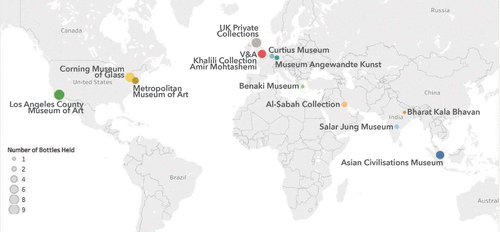
In this article, I propose that the significance of these glass bottles hinges upon their boxed presentation, even if most are no longer associated with their original cases, but also on their now lost contents. Based on documentation provided by the records of the Dutch East India Company (Vereenigde Oostindische Compagnie, VOC), we may conclude that boxed sets of this type were used to convey aromatic liquids and presented as gifts to high-profile recipients around the vast scope of the Indian Ocean in the final decades of the seventeenth century into the first half of the eighteenth. This proposal hinges upon a chain of connections that link glass vessels to porcelain ones and both types to their associated wooden containers, across networks of distribution that extended from the Red Sea to the courts of Southeast and East Asia. By crossing boundaries of medium and highlighting both the practical and experiential dimensions of these highly mobile, much-dispersed, and valuable goods, I bring to light the pressing and specific cross-cultural demands that were placed upon these gifts of glass and porcelain, thus recasting their identity from isolated items of decorative interest to parts of assemblages that were deployed instrumentally in the extended commercial networks of the Dutch overseas empire.
Glass Bottles from India
These bottles are often included in the wider category of “Mughal glass,” despite the fact that numerous debates about their production have not yet been resolved. Although evidence for Indian glasswork dates as early as 1200 BCE, large glass vessels were not produced there until much later and are generally associated with the increasing European presence on the subcontinent after 1500.6 In 1969, Moreshwar Dikshit offered the earliest opinion on these painted bottles, characterizing them as European exports, or more specifically, Dutch bottles “manufactured for the Indian market,” based on their angular profiles and narrow openings, which mirror the form of the classic Dutch gin bottle (fig. 8).7Dikshit also surmised that European artists executed the painting in a style that mimicked Indian conventions for the purposes of local marketability.8 His dating of 1725–30 was based on four bottles of this type in the Victoria and Albert Museum (V&A), which each have a Dutch silver coin, a scheepjesschelling worth six stuivers, as a cap, attached by a chain to the collar around the neck (fig. 9).
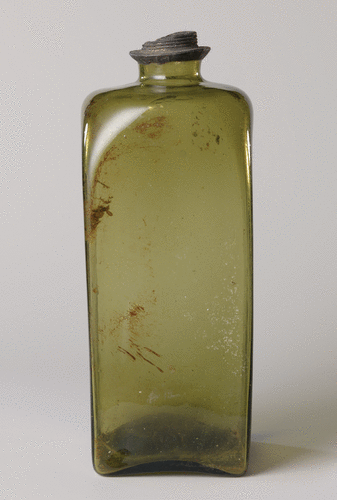
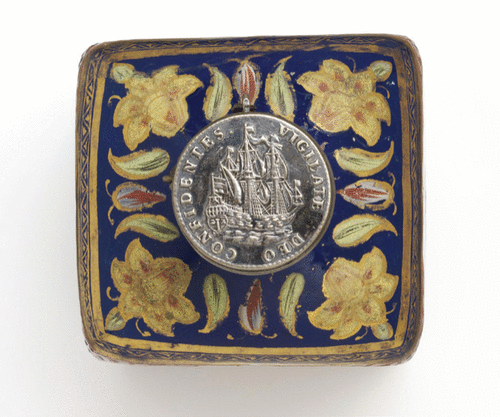
Indeed, in the seventeenth and eighteenth centuries, India emerged as an eager market for European glass, both fine and mundane, from Italy, Bohemia, and other areas.9 And, as the Los Angeles County Museum of Art curator Stephen Markel has shown, European glassmakers began to produce items specifically for Indian consumption by the late seventeenth century.10 Even so, the scholars who have responded to Dikshit, such as Simon Digby, Susan Stronge, Markel, and Stefano Carboni, have generally rejected his claim that these gilded square-based bottles were designed in Europe for export to Asia, arguing rather that they were made in India (likely Gujarat) and certainly decorated there, thus undermining the proposal of European painters adopting an Indian style.11 On the date, Stronge attributed the Dutch coins on the caps of those V&A specimens to the 1670s, thus pushing Dikshit’s chronology back in time.12 Yet Markel and Carboni have suggested that the bottles may have been produced under the influence of the glass factory that Maharao Lakha of Kutch (r. 1741–60) established in Bhuj in the middle of the eighteenth century. This intriguing yet unverifiable connection would extend the date of the bottles decades later.13
Even if Dikshit’s attribution of Dutch objects “manufactured for the Indian market” has been discounted, the idea that the bottles were made in Europe and only decorated in India still persists.14 It is clear that these questions may not be settled easily, even by compositional testing. According to Carboni, the bottles in the al-Sabah Collection reveal lead potash, which suggests European manufacture but could also mean that European ingots were sent for smelting in India.15 As a result, these bottles remain locked in a classic East-West binary configuration, which may either confirm or challenge assumptions about the directional nature of technology transfer. For that reason, the goal of this article is not to determine, ultimately, whether these bottles should be assigned a European origin or an Asian one.
Even so, the Dutch, in particular, must be attributed a role in the development and conception of Indian glassworks during this time. The Dutch had engaged in Indian trading networks since the early seventeenth century and had established several long-standing factories along India’s coasts to facilitate their activities. Along with the English, they were providers of European glass for the local market, including bottles, glasses, spectacles, mirrors, and other items.16 Case bottles, filled with alcohol or empty, were in high demand, particularly for gifts. According to Dikshit, old Dutch gin bottles could still be purchased in the city of Surat in the 1960s, which attests to the longevity of these imported glass products in coastal India.17 The Dutch connection is further emphasized by the coins that served as caps on four of the bottles, as mentioned above (fig. 9). Ram Singh Malam, the lead artisan at the glass factory in Bhuj, who was also famous for designing the city’s glass- and mirror-filled Aina Mahal, had learned his art in the Dutch Republic and made two additional trips to Europe to further his knowledge.18 Thus, considerable evidence points to a connection between Dutch and Indian glassworks in the late seventeenth through the eighteenth century. Yet we cannot say whether Dutch products and industry served as guiding examples for Indian glassworkers or if the Dutch were more actively responsible for cultivating this sector in India.19 By extension, we should call into question the assumption that all the glassware that the Dutch used in Asia was imported from Europe during this time.20 Indeed, glassblowers were present in the Dutch capital Batavia (modern-day Indonesia) by the year 1676, and it is clear that some vessels were produced in Asia as well.21
From India to Japan (via Batavia)
This corpus of Indian glass bottles is usually examined in relation to other items of glass, such as the prized gilded huqqa bowls that are also associated with Mughal production. Yet it is useful to expand this analysis outside the world of glass to draw attention to similar items made of porcelain. Immediately relevant to the Corning and ACM examples is a segmented box in the Amsterdam Rijksmuseum that is outfitted with nine porcelain bottles that are presumed to be original (fig. 10).22 As with the Corning and ACM vessels, each bottle sits on a square base, with a sloped shoulder and a narrow neck. Made of white porcelain and underglaze painted with a repeating prunus motif in cobalt, each bottle has a silver cap, likely replaced in the nineteenth century.23 In this case, the Dutch association is undeniable because the VOC insignia is branded on each of the unglazed bases (fig. 11). The interior of the box, made of calamander wood, is lined with cord-edged red velvet, now faded.24 Another similar box with larger porcelain bottles that are painted with figural imagery in enamel, in the collection of the Peabody Essex Museum in Salem, Massachusetts, suggests that the Rijksmuseum box is not a singular example (fig. 12).25 Individual porcelain bottles of the same sizes and shapes can be found in other collections, as with the glass examples mentioned above.26
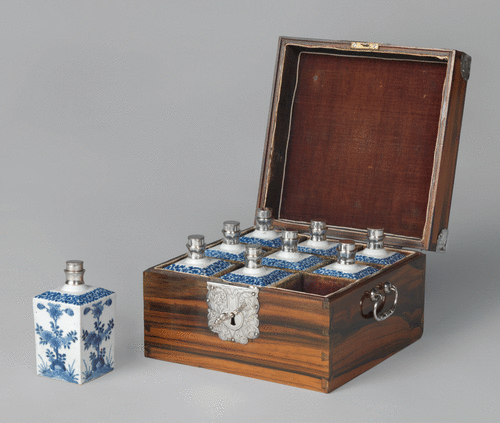
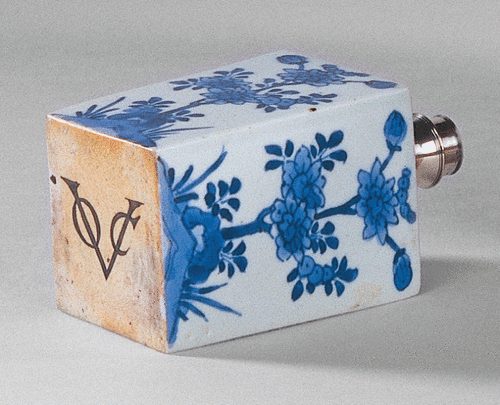
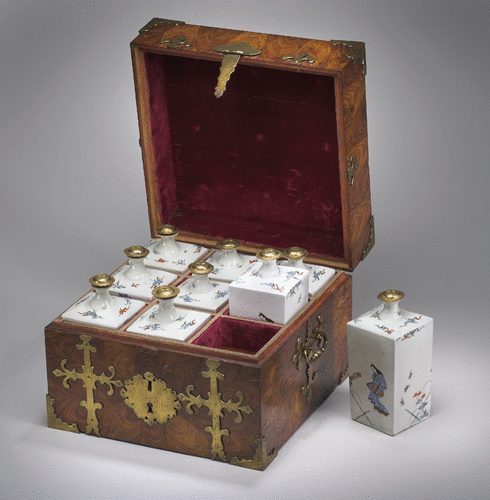
The Rijksmuseum box is important not just because of its fine state of preservation, but also because it is undergirded by textual records that provide a context for its production, as studied by the VOC historian Cynthia Viallé. Thanks to Viallé’s work, it is possible to understand the detailed process of commissioning porcelain bottles of this type and their associated boxes, information that is not available for their glass counterparts.27 In 1686, VOC officials in Batavia sent a message to Andries Cleijer, the head of their establishment in Deshima, near Nagasaki, asking him to initiate the production of six boxes along with the bottles to be held within. After stating clearly that the boxed sets were intended as gifts and specifying that they were to be “curious,”28 they then proceeded to offer an extraordinary amount of detail in regard to the boxes’ specifications. Four were to be made of sandalwood, using pieces that had been sent over to Japan expressly for that purpose. Of the four sandalwood boxes, two were to hold nine bottles and the other two were to hold six. They also specified that two of the sandalwood boxes were to be provided with silver fittings and the other two with brass ones. The remaining two boxes were to be made of camphorwood with brass fittings, outfitted for nine bottles of twelve ounces each. In regard to the bottles, they were to be crafted of porcelain at nearby Arita in two sizes, with twelve- or sixteen-ounce capacities, based on wooden models provided by a merchant named Sweers. They also asked that the porcelain be the “whitest and finest” with the “most beautiful blue painting and with silver caps.” The VOC merchants of Deshima were unable to fulfill this order during that season, so the items arrived in Batavia near the end of the following year. Ultimately, they complied with only some of the very exacting provisions of the commission, returning six boxes made only of sandalwood, four with silver fittings and the other two with brass ones, along with one hundred matching bottles of a single, yet unspecified, size.29
The insatiable early modern global demand for Asian, and especially Chinese, porcelain is documented amply and need not be rehearsed here. Although often underemphasized compared to the more famous kilns at Jingdezhen, Arita in Japan also produced pieces for the global marketplace and played the important role of supplying wares during the tumultuous period of the Ming-Qing transition (ca. 1640–83), which affected the production at and transport from Chinese kilns. After that period, the Japanese porcelain trade was mainly handled privately, although the VOC continued to place orders for intra-Asian dissemination, as with this 1686 commission. It was not uncommon for Dutch patrons to provide prototypes for the porcelain shapes that they desired at both Jingdezhen and Arita.30 They also became increasingly specific about their desired design programs, as evidenced by the many examples that carried European coats of arms and the oft-repeated Orientalizing designs of the Dutch artist Cornelis Pronk (1691–1759), for instance. While the porcelain bottles of the Rijksmuseum box are clearly based on the classic Dutch bottle form, as with the glass versions made in India discussed above, they are not exact replicas of them. Both are much smaller than their Dutch models, and the Rijksmuseum bottles have sharper edges.31 As for the box, the Rijksmuseum specimen in calamander wood does not appear to be a product of that 1686 commission, which yielded only sandalwood containers. The city of Batavia had an active woodworking quarter, which is probably where the Rijksmuseum box was made, even if its bottles came from Japan.32 By the same right, the ACM box, with its six gilded glass bottles made in India, was likely also produced in Batavia, but of rosewood (see fig. 3).33
The 1686 commission, studied by Viallé, is important because it indicates that the preparation of boxes and bottles of this type required the oversight of a number of trade officials and merchants from Batavia to Deshima to issue orders and supervise shipping, as well as the labor of many craftspeople working in diverse materials—wood, textile, metal, and ceramics—in far-flung quarters. The commissioning of any single object of this nature also required extensive long-distance communication via paper and in person through various interpreters, in addition to many months of waiting. When situated within this wider understanding, the box in the Rijksmuseum exceeds its modest size, providing compelling material evidence that the enterprise of gift giving in the Indian Ocean was no small matter for the VOC, a point made amply by scholars such as Viallé, Adam Clulow, and Martha Chaiklin.34 It also provides a wider context for the boxes with glass bottles mentioned above, which may be linked to those in porcelain not just because of their form and components, but also because of their function as gifts.
Networks of Distribution
In addition to presenting the circumstances of production of these boxes, Viallé indicates that after the bottles were made in Arita and shipped back to Batavia, they were to be filled with aromatic oils, pressed from substances such as sandalwood, cinnamon, clove, mace, and nutmeg.35 Heavy with perfumed liquids, the porcelain bottles were then placed into their bespoke segmented boxes and doled out to the ruling authorities of selected polities across the Indian Ocean and maritime Asia. In her 1993 article, Viallé provides the following list of dignitaries who received boxes of this type, with an interest in ascertaining those who may have been the beneficiaries of the 1686 commission.36 Likely candidates include King Phetracha of Siam, who received two boxes of oils in 1688 and 1692, and the sultan of Banten on the island of Java, a close neighbor to the Dutch in Batavia, who received such a box in 1690. Additionally, the negus of Ethiopia, Iyasu, received two boxes of this type in the years 1691 and 1696. In a later 2006 article, Viallé adds three additional recipients to this list: the sultan of Johor on the Malay Peninsula and his young regent, who each received a boxed gift of oils in 1687, and the Qing emperor, who received one among many other items brought by the VOC envoy Vincent Paats in 1686. However, she does not mention whether these last three boxes contained bottles made of porcelain or glass. To Viallé’s rosters, we may add two boxes of scented oils in glass vials that were delivered to the Qasimi imam of Yemen in 1719 and 1735.37 Without question, this list of recipients is not exhaustive. It is certain that, upon sustained study, the voluminous VOC archives will continue to yield many more examples of such distributions. But, even based on this preliminary list, we may map these boxes, with vessels of porcelain and glass, across a wide matrix of Dutch gift giving that extended all the way from the Red Sea arena to East Asia from the 1680s into the first decades of the eighteenth century (see fig. 13). While Viallé laid the groundwork by identifying most of these recipients, she did not venture to propose the meaning or significance of these boxes.38 Accordingly, this article builds upon her findings by demonstrating the value of these boxes and proposing what they were meant to accomplish as gifts to specific recipients in their localized historical contexts.
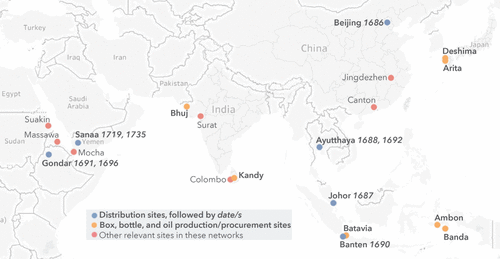
Some recipients were given boxes of this type on more than one occasion. For instance, in September 1688, a sandalwood box with silver fittings was bestowed on the king of Siam, Phetracha, based in his capital, Ayutthaya. The documents of VOC merchants convey that this box was filled with bottles of clove, nutmeg, mace, cinnamon, and sandalwood oils. Based on the overall quantities that were recorded, we can assume that the box held nine bottles, each with a capacity of twelve ounces, and that all the oils, except for the sandalwood, were provided in doubled quantities and two separate containers.39 The VOC merchants offered another sandalwood box of a similar size, but with brass fittings, to Phetracha in 1692. When the now-ruined palace at Ayutthaya was excavated, archaeologists found square-shaped porcelain fragments of bases stamped with the VOC insignia, like those of the Rijksmuseum bottles.40 It is impossible to say whether these fragments came from the 1688 or 1692 gift, or another one that has not yet been studied, but this archaeological evidence provides material support for the successful execution of at least one of the diplomatic bestowals described in the textual sources, as well as confirming the enduring presence of a VOC gift at the king’s court. The long-term preservation of this gift at Ayutthaya, even in fragmentary form, is quite remarkable in a world in which gifts, even valuable ones, were sometimes rejected or passed on to someone else.41
As described vividly by the historian of early modern Thailand Bhawan Ruangsilp, from 1604 to 1765 the VOC merchants based in Ayutthaya carefully managed the complicated and rapidly changing politics at the Siamese court, where they enjoyed moments of clear favor, but also those of relative exclusion.42 The above-mentioned gift of 1688 was not intended for Phetracha, the Thai king who is sometimes cast as xenophobic, but rather for his outward-looking predecessor Narai, who had died that year. In fact, in 1685, French and Persian embassies had appeared in Ayutthaya with great fanfare and carrying lavish gifts.43By 1688, Narai avidly courted French merchants and missionaries, while the Dutch feared that their own presence was being greatly overshadowed.44 The gift of boxed oils, along with a carriage and six black horses, was one of the items bestowed in response to the high intrigue and intra-European competition at the court of Narai, all of which was mediated by the Greek minister and patron of the French, Constantine Phaulkon, who wielded considerable influence over the Thai king. Of course, by the time the box arrived in Ayutthaya, Narai had died and was succeeded by a king who was much less interested in entertaining foreign embassies at court or dispatching missions abroad.45 Clearly, the Dutch offered the box as a tool to vie for influence and trading privileges at a time when they saw their position as quite vulnerable. The fragility of their situation may also help to explain the detailed nature of the 1686 VOC order to Deshima, which reveals that they were deeply committed to producing gifts made to specification so that they would be received well. Carefully composed gifts could be directed toward delicate cases, such as that of Siam, where the Dutch constantly had to renegotiate their position, while also jockeying for preeminence among other European rivals.
In the late seventeenth century, two boxes of oils were also given to the negus of Ethiopia, where, in contrast to Siam, the Dutch did not maintain an established presence. The historian Matteo Salvadore has shown that the middle of the seventeenth century marked a new era of external relations for Ethiopia. Whereas Negus Susenyos (r. 1606–32) made the controversial decision of committing to Catholicism in the waning years of Portuguese maritime dominance in the western Indian Ocean, his successor Fasiladas (r. 1632–67) rejected those short-lived policies by expelling or executing the remaining Jesuit missionaries in Ethiopia and then initiating new relations with certain Muslim and Christian states as part of “a conscious decision of selective isolation from the Catholic world” but also a clear desire to reap the financial benefits of the long-distance maritime trade.46 This rationale explains why Fasiladas sent embassies to Muslim rulers who occupied strategic maritime positions, including the Qasimi imam of neighboring Yemen, the Ottoman sultan who held the Red Sea ports of Massawa (modern-day Eritrea) and Suakin (modern-day Sudan), and the Mughal ruler Aurangzeb. His successors Yohannes (r. 1667–82) and Iyasu (r. 1682–1706)47 expanded these initiatives, with additional missions to the Mughals, but also the VOC. In 1673, 1689, and 1694, three embassies were dispatched from Gondar to Batavia.
For each of the Batavia missions, the Ethiopian ambassador was Khoja Murad, an Armenian, originally from Syria, who brought with him standard gifts of horses and slaves, which were enhanced by rare items of value, such as zebras, ostriches, and animal horns full of civet musk. In both 1691 and 1696, Khoja Murad returned to the capital, Gondar, with copious gifts for the negus from the Dutch. In these two instances, they included, among many other items, boxes of fragrant oils.48 The 1691 box was made of sandalwood and held oils pressed from cinnamon, sandalwood, camphor, nutmeg, mace, and clove, which were apportioned in large porcelain bottles, likely from Arita, of sixteen ounces each, with the nutmeg, mace, and clove oils offered in doubled quantities.49 The Dutch interest in opening direct trade relations with the Horn of Africa stretched back to the early seventeenth century, with the establishment of the short-lived “Company of Abyssinia,” which foundered because of VOC concerns that this new institution would infringe on their territory.50 But these late seventeenth-century embassies initiated by the negus revived Dutch interest, eventually inspiring the VOC to attempt a return mission to Gondar, despite Khoja Murad’s warnings about the possible risks of such an endeavor. The Dutch mission proceeded to the Red Sea port of Mocha, where they had long held a trade establishment, in 1696. They waited pointlessly for Khoja Murad to send word that they could proceed to the African coast safely, as he had promised. As a result, the embassy was eventually abandoned and the ambassador, Theodorus Sas, left Mocha without ever crossing the Red Sea. Even though they turned out to be unsuccessful, these diplomatic gifts and attempts at contact represent the long-standing VOC aspirations for commercial expansion into the Horn of Africa.
The Dutch also bestowed two boxed sets of oils on the imam of Yemen, in 1719 and 1735. In contrast to Ethiopia, the Dutch had traded in Yemen since 1616, when the area was ruled by the Ottomans, but sustained their presence there after the Qasimi imams ousted the Ottomans in 1636. The first box of oils reached Imam al-Mutawakkil Qasim soon after he had dominated in a drawn out struggle against two contenders, Imam al-Mansur Husayn (d. 1720), whose support was concentrated in the northern mountain town of Shahara, and his uncle al-Mahdi Muhammad bin Ahmad (r. 1686–1718), who was based in the hilltop fortress of al-Mawahib and had originally recruited Qasim to support his campaign. Qasim had ended up turning against his uncle to claim the title of imam for himself and eventually gained strategic control of the lowlands, including Mocha. Dutch merchants, who were based in that port and observing these events closely, decided to lend their support to the new imam, who took the title al-Mutawakkil. Their choice proved to be the right one. With the death of al-Mahdi in 1718, Qasim was able to claim authority over most of Yemen, while the purview of the last imam contracted considerably. On March 4, 1719, these merchants transmitted a letter, along with a large gift package, to al-Mutawakkil in Sanaa, on behalf of Christoffel van Swolle, governor-general of the Dutch East Indies based in Batavia.51 Along with copious textiles, spices, porcelain coffee cups from China, and five pairs of glasses, it included a box that contained cinnamon, clove, and nutmeg oils, each meted out in a two-ounce bottle, as enumerated in a gift register from that year (fig. 14).52 Although this box and its vessels were considerably smaller than those conveyed to the courts at Ayutthaya and Gondar in previous decades, this bestowal is important because it specifies that these vessels were made of glass, and thus serves as a crucial link that connects the function of the Corning and ACM boxes to that of the well-documented Rijksmuseum example.53 This bestowal from the VOC’s top official in Asia acknowledged the imam’s newly attained singular standing and conveyed wishes for the stability of his reign. The letter also explicitly outlined the VOC’s wish to maintain their trading privileges, particularly their access to the region’s coffee beans, a local commodity that was still in demand while European cultivation efforts were just beginning to find success on the islands of Java, Martinique, and Île Bourbon (now Réunion).54 Indeed, al-Mutawakkil’s box was tendered at a fragile political moment when a new and untested imam had just consolidated power. Although VOC merchants had supported him early on, they still feared that their status, and accordingly their access to local supplies of coffee, might be diminished by a new trade agreement.
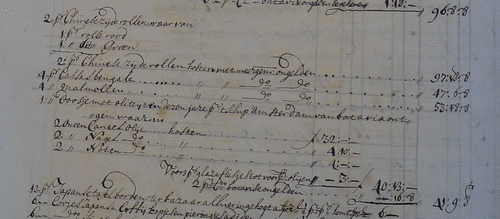
VOC merchants gave a similar box to al-Mutawakkil’s son and successor, Imam al-Mansur Husayn (r. 1727–48; not to be confused with the imam of the same name and title who was based in Shahara and mentioned above), in 1735.55 Again, the reference is sparse, but it conveys that this box was larger than the previous one, with four containers of cinnamon, mace, clove, and musk oils for a total of ten ounces. However, in this case, the material that the bottles were made of was not mentioned. The oils, however, were described as “fine,” and the set had been sent to Mocha in 1730, five years earlier.
Clearly, these boxed sets of oils were considered to be impressive gifts, offered to the rulers of these three polities on more than one occasion. Yet one notable recipient did not appreciate these much-distributed items. In 1685, the Qing court requested that the VOC deliver an embassy, with the threat that they would not be allowed to trade again until one was sent.56 They were, in fact, long overdue, having promised to dispatch one every eight years; eighteen years had passed since the last Dutch mission to Beijing. In 1686, the VOC envoy, Vincent Paats, presented an impressive gift package to the Kangxi emperor, which was worth 30,000 guilders, in addition to 31,000 guilders’ worth of gifts that were dispensed en route to the court from Fuzhou.57 Among coral, mirrors, textiles, a clock, a lantern, a candelabrum, glassware, spices, weapons, casks of wine, and telescopes, the package included a box with silver fittings that held small bottles of cinnamon, clove, rose, and sandalwood oils.58 Unfortunately, these hefty expenditures did not pay off. Paats’s requests for toll exemptions and permission for the establishment of permanent trade facilities in Qing territory were not approved. This unyielding response was surprising, as the Qing court had already relaxed restrictions on trade with other foreigners. But, as Thomas DaCosta Kaufmann has shown, the embassy was not considered a success. The Dutch generally struggled to calibrate the proper gifts for the Qing emperor, who was not always pleased with the stock items delivered to others around the Asian sphere.59 After the conclusion of the embassy, it was conveyed to the Dutch that, in the future, their gifts should include horses, red coral, large mirrors, European woolen cloth, Persian rugs, clocks, certain spices and aromatics, amber, and firearms, but not Spanish wine and boxed sets of aromatic oils, among other items.60 In this case, it appears that the boxed oils contributed, at least in some small part, to the failure of the mission. Shortly afterward, in 1690, the Dutch diverted their attention away from direct trade with China, with the intention of obtaining the same products through Chinese shipping to Batavia instead.61 They waited until 1729 to resume their direct trade with China from their new base in Canton.
These bestowals in Ayutthaya, Gondar, Sanaa, and Beijing demonstrate the compelling paths that these boxes of aromatic oils could take, even if they present only a partial picture of the scope of VOC gift giving. As emphasized here, chests of aromatic oils were bestowed in delicate diplomatic situations, where VOC merchants hoped to improve their liminal position, or in regions where they endeavored to establish new commercial ties, such as Ethiopia. But, as Zoltán Biedermann has shown for elaborately carved ivory caskets made in Sri Lanka in the sixteenth century, we must endeavor to “reconnect” these items, which are now cast as “decorative,” to their “distant, politically loaded past.”62 In that light, these gifts represent the relatively fragile place of the VOC in late seventeenth- and early eighteenth-century Indian Ocean and Asian commercial networks, not their preeminence. Clearly, boxes of aromatic oils were deployed as prized gifts, used to develop favor locally and particularly in cases where Dutch trade privileges were not stable or assured. Although these boxed oils may not appear to have been the most prominent items in the gift packages that they were sent along with, their repeated dispatch to Ayutthaya, Gondar, and Sanaa demonstrates their potential value and impact. Whereas raw commodities, such as spices, and certain luxury textiles were quite universal in their appeal across the Indian Ocean, more complicated, multipart, manufactured items were more challenging to calibrate. For instance, in 1688, upon receipt of his gift package from the VOC, King Phetracha told these merchants flatly that he did not need the carriage, so it was returned to Batavia, although he kept the horses, along with the box of oils.63
The Value of Aromatic Oils
These gifts were sumptuous thanks to the high-quality materials that their parts were crafted from: tropical and aromatic hardwoods, glass, porcelain, velvet, and silver. Yet they drew their value from their contents. Fragrant oils made from spices, such as mace, clove, nutmeg, and cinnamon, and aromatic woods, such as camphor and sandalwood, were treasured around the Indian Ocean and used in perfume blends, as toiletries, or to make incense, but also for medicinal purposes. They were costly because large quantities of each product had to be used to render even a small vial of oil. For instance, in 1719, two ounces of cinnamon oil were given to Imam al-Mutawakkil in Yemen and valued at thirty-two guilders, whereas fifteen pounds of bulk cinnamon by the sack was valued at only four guilders in total.64 These oils represented concentrated essences of much-desired spices, which were actively traded by the Dutch and often bestowed in gift packages in other forms as well, such as dry bulk or candied preserves. For instance, in the 1719 gift to al-Mutawakkil, the boxed presentation of cinnamon, clove, and nutmeg oils was doubled in impact by voluminous sacks containing the very same spices. Moreover, there were large disparities between the costs of the different types of oils. In 1719, the bottle of cinnamon oil was eight times more expensive than that of clove or nutmeg.
It is important to note that fragrant oils appeared commonly in annual VOC gift packages to polities across the Indian Ocean. As Viallé describes, the Dutch regularly gave vials of clove oil to the shogun and his officials in Japan, usually in quantities of one to five ounces.65Moreover, Viallé refers to the VOC establishments in India as “loyal customers” of these oils, which were always used for gifts and usually given in small quantities of a few ounces at a time.66 It is clear, however, that boxed sets including multiple large bottles, as exemplified in figures 1, 3, 10, and 12, were reserved only for the most important recipients, such as those mentioned in the previous section, the king of Siam, the negus of Ethiopia, the imam of Yemen, and the Qing emperor. This hierarchical stance toward distribution was clear in 1719, when Imam al-Mutawakkil received his boxed set. At the same time, his wazir, or main advisor, Salih al-Huraybi, and the governor of the port of Mocha, Amir Rizq Allah, also received gifts. Theirs included the same varieties of aromatic oil, but in individual bottles and smaller quantities of one ounce each. Al-Mutawakkil’s box stands apart from these other examples because of its packaged presentation, apparently the first time that the Dutch had offered oils to a Yemeni recipient in this way, rather than as loose vials. This manner of wrapping allowed them to scale up a common gift item for a particularly fine, and apparently exclusive, bestowal. The elevated intention of these boxed presentations was made clear again in Yemen in 1735, when Mocha’s head sarraf, or money exchanger, and the merchant Hasan Hasusa came seeking gifts of red laken (broadcloth) and “fine oils” from the Dutch.67 Although they initially bristled at this demand, the VOC merchants ended up dividing the broadcloth, which was in danger of deterioration in their warehouse, among the following recipients: Imam al-Mansur, Mocha’s governor, his second in charge, the head sarraf, and the merchant Hasusa.68 But they reserved the box solely for the imam. In fact, that box had arrived in Mocha in 1730 and had been retained for five years, signaling that the VOC merchants posted there would not offer such an item to a lesser recipient or sell it on the market. Gifts were never intended to normalize or equalize social standing. To the contrary, they indicated that VOC representatives understood the nature of local ranks and could acknowledge these differential roles effectively. Flasks of fragrant oil could be increased in impact considerably when assembled in ornamental boxed sets, which were clearly reserved as special presents for esteemed beneficiaries, thus crystallizing regional hierarchies in vivid material terms.
The governor-general in Batavia operated with relative independence in Asia, running the VOC as both a corporate organization and a state-like entity that initiated relations with other regional powers on its own terms. Generally, the company used two approaches in external affairs, conquest and diplomacy, as described eloquently by the historian Leonard Blussé.69 They managed their hold on key spice monopolies through violence, as in the Banda Islands, where they had decimated the local population in order to control supplies of nutmeg and mace in the early seventeenth century. In Ambon, during the same period, they tortured and executed their competitors to retain their hold over cloves, while also destroying their crops and property. In sharp contrast to these violent acts carried out for commercial gain, VOC merchants engaged other Indian Ocean polities through strategic diplomatic relations, facilitated through costly embassies, such as those mentioned above. These dual approaches are represented clearly through the Dutch engagement on the island of Ceylon, modernday Sri Lanka. In 1656, with the support of the inland raja of Kandy, the Dutch took the strategic sites of Colombo and Galle from the Portuguese, who had long held forts on the island. But they then turned against the raja, who dominated the regions where cinnamon was most plentiful. After pursuing two futile decades of war, they were compelled to change their approach, finally settling on a treaty that hinged upon a delicate policy of diplomacy. The historian T. B. H. Abeysinghe records that the VOC sent fifty-one embassies to Kandy in the first half of the eighteenth century, which indicates the continuing importance of that strategic relationship and their enduring need to acquire cinnamon.70Their differential approaches to these various polities must be understood when considering VOC practices of gift giving and particularly the place of spices within them.
Unlike other common perfumed liquids, such as rosewater, for instance, which had a long history of use in the Middle East and was produced in Persia and India, spiced oils were processed in Batavia and seem to have become more widely available after the early seventeenth-century settlement of the Dutch. The primary oils were drawn from the spices that they controlled aggressively, such as nutmeg, mace, and cloves, their key Eastern products. When processed as aromatic oils and poured into bottles that bore the VOC monogram on their bases, these pungent products cogently and potently expressed the extensive realm of Dutch economic power, territorial access, and military control. They were then boxed and delivered to those whom they wished to cultivate through the “soft-handed approach” of diplomacy in Yemen and Siam or aspired to forge relationships with, such as the negus of Ethiopia.71 For that reason, it is no accident that oils of clove, nutmeg, and mace were offered most commonly in these gift boxes, often in doubled quantities.
Nested Containers
Despite the isolated negative response of the Kangxi emperor, VOC officials in Batavia saw these boxed sets of oils as ideal gifts to high-profile recipients within the Indian Ocean arena at the end of the seventeenth century and the beginning of the eighteenth. Even though some specimens of boxes and bottles have been preserved in Western collections, their well-documented role as gifts within the Indian Ocean and Asian spheres must be emphasized.72Hence, they should not be folded into the wider category of objects grouped under the term “export art,” even if the patrons were European and they were intended for consumption outside the place of production. Based on the evidence presented above, it appears that the bottles could be made of porcelain or glass; there is even a set of six metal bottles ornamented in pearl-shell and lacquer, housed within a box made of the same materials in a Japanese collection.73
I am not the first to link these glass bottles with their porcelain counterparts.74 What I offer, however, is a way of understanding their relationship as more than a material outcome of Dutch cultural influence. The shape of these glass and porcelain vessels is important not just because they seem to replicate the form of the Dutch case bottle, but rather because that shape, with its angular corners, was designed so that it could be tightly wedged into an individual compartment within a segmented box intended for travel.75 Like Dutch case bottles, these flasks of aromatic oils were engineered for maritime conveyance, ultimately destined to enter the hands of a faraway recipient in one piece. In the case of the Rijksmuseum box, we can map much of the lengthy trajectory of its parts, beginning in Japan where the bottles were made, then to Batavia where the box was manufactured and the items were assembled, and eventually all the way to Amsterdam.
Dutch gin bottles, such as the one that Dikshit purchased in Surat in the 1960s, must also be understood in relation to their contents. They were not sent for sale overseas in Asia, but rather arrived in Eastern ports on VOC ships, filled with spirits meant to sustain the employees of the company. These bottles, heavy with liquid, were packed within wooden boxes, or kelders, which were segmented, usually into fifteen compartments, to prevent breakage.76 Countless bottle-filled kelders were sent on boats from Amsterdam to all corners of the maritime sphere in which the Dutch operated, as part of the extended industry of provisioning this expansive enterprise of trade and foreign settlement.77Although some seventeenth- and eighteenth-century glass bottles of this type still remain in museum collections today (see fig. 8), empty of course, their associated boxes usually do not.78 In order to understand the impact of Dutch case bottles in the Indian Ocean more fully, we should not see them as isolated objects emptied of their contents.79 Rather, we must envision them filled with the liquids that they held, while also placing them back into the crates that were outfitted to carry them across the seas.
In the context of gifting, the nesting of these goods was not only a practical consideration, however. As signaled above, this mode of packaging was used for exclusive bestowals on established rulers of Asian and African polities, but never on their subordinates. These boxes allowed VOC officials to elevate the presentation of spiced oils that were distributed more commonly as loose vials, as described above. This concentric packaging also enhanced the object’s progressive impact upon opening. When delivered, the recipient would lift the latch of the box and then open the lid. The sandalwood boxes commissioned by the VOC in 1686 would have emitted a pleasing aroma even before opening, thus providing a preview of the fragrant content within.80 The sumptuous interior, covered in plush velvet, would first reveal only the metallic tops of the individual containers. Each glass or porcelain bottle would have to be removed independently in order to view its decorated surfaces, with gold and colors on glass or pigments on white. Finally, each vessel would be uncapped to reveal the fragrant oil within. This type of “wrapping” targeted the senses, not just visually, but also through touch and smell. As described by the art historian Avinoam Shalem, the experiential aspects of transporting, offering, and opening gifts, what he calls the “performance of the object,” must be taken into account when considering the material dimensions of any received item.81 Although Shalem speaks particularly about the medieval and early modern Middle East, his discussion of gifts that were presented in experientially dynamic ways, usually nested within precious containers that were themselves wrapped in valuable textiles that were also sometimes enhanced by fragrance, is useful for understanding this corpus of boxed gifts. These notions of sensory delight and experiential drama may also help us understand why these VOC caskets worked so effectively as gifts for most recipients across a vast maritime sphere, including areas in and adjacent to the Islamic heartlands.
Equally compelling is the historian Emma Flatt’s discussion of the “transformative power of smell” in the sixteenth-century Deccan. Drawing attention to the use of olfactory elements in esoteric practices of conjuring spirits, she demonstrates that scent was not purely an aesthetic concern in early modern India, but also carried a generative clout.82 It appears that the VOC officials who were charged with commissioning these gifts were similarly aware of this key olfactory dimension, which held relevance in other parts of maritime Asia as well. In regard to the 1686 order discussed above, the Dutch merchants at Deshima decided not to follow through with the requested chests of camphorwood, claiming that they were “judged to be inappropriate” because the strong scent of the oils within could “infect” the fragrance of the box.83 For that reason, they executed the order only in sandalwood, which they apparently found to be more robust in this regard. This deviation from the Batavia request is telling, for it suggests that these merchants were considering the sensory, and particularly olfactory, dimensions of the object in its complete assemblage as key to the gift’s overall success. Notably, their superiors in Batavia agreed that they had made the correct choice in this matter. While it is acknowledged that the Dutch generally conformed to court protocols and social norms in the overseas sites where they did business, the subtle and indeed ephemeral codes of interaction, such as the management of sensory impact, have yet to be addressed.84
In fact, fragrance should be emphasized as a central dimension to a gift’s character, as demonstrated in a large gift package that the VOC sent to Narai in 1681. This assemblage did not include any boxed oils, but it did feature a number of European-made objects that had been much delayed in conveyance: a gold timepiece, two decorated telescopes, six “elegant writing-books,” and the “best pairs of spectacles for people of varying ages.”85 In addition, they sent over a large and expensive brass lantern, some rare animals, many pieces of precious textiles, glass from Europe, and numerous objects that were crafted of cinnamon wood. This type of wood was rarely used functionally because it was difficult to procure pieces that were large enough to carve. A small cabinet with gold mounts, four halberds inlaid with silver, four canes, a tray, and twelve goblets, all made of cinnamon wood, would have been notable and unique additions to this gift package. The tendency might be to focus on the European-made items in this assemblage or those that were wrought of silver and gold for their considerable expense.86 Instead, we should underline the aroma that these gifts made of cinnamon wood, obtained from Sri Lanka, would have emitted, effects which the Dutch were also clearly attuned to. Indeed, the following year’s gift also included a cabinet and weapons made of the same perfumed material. By privileging the experiential power of gifts, we shift the perspective away from the regimented order of monetary evaluation that dominates the conventions of VOC documentation, while also circumventing the overriding fascination with the consumption of Western goods in the East (and vice versa), even as these olfactory dimensions are difficult to recapture historically.
Conclusion
Wooden boxes that housed bottles that were filled with fragrant oils may be clearly associated with Dutch patronage across this vast maritime sphere, even though questions about the place of glass production, for instance, may never be answered satisfactorily. And the many corresponding individual decorated bottles of glass or porcelain with square bottoms and flat sides that can be found in global museum collections may be better understood when conceived along with the segmented boxes that were made for their conveyance, storage, and presentation, even if the majority of these containers are now irretrievably lost.87 As Andrew Shryock and Daniel Lord Smail recently declared, generally “the container is overlooked in favour of other kinds of things, typically prestige goods, identity markers or objects that oscillate between commodity and gift states.”88 These boxed sets compel us to consider containers and contents in an integrated fashion, while also shedding light on their implicit concentric relationship. In fact, we may go as far as to say that the conditions of enveloping and containing were key to the production of an Indian Ocean material culture that drew on many traditions and precedents, but was ultimately geared for types of exchange that took shape across the unstable waters of the sea. It is this relationship between form and the circumstances of conveyance that orients the relationship between the boxes and the bottles that they once held, as well as their central role in cross-cultural gift giving.
Recently, several important studies have aimed to elucidate the character, intention, and impact of VOC gifting practices. Viallé has examined the ways that VOC envoys assimilated to local court protocols around the Asian sphere, even if their efforts sometimes fell flat.89Claudia Swan has proposed that VOC diplomatic gifts—even exotica—must be understood through a commercial lens, thereby recognizing the intertwined nature of the diplomatic sphere and the marketplace, particularly during the height of VOC economic success in the first half of the seventeenth century.90 This essay echoes most of the key points of both essays, while adding to them, by taking up a limited, and highly particular, class of gifts with specific properties that would have had a pointed impact upon recipients in the Indian Ocean and across the Asian seas.91 To this end, I have highlighted the features that made these boxes practical but also alluring gifts, while departing from the standard defining conventions of the VOC, which hinge upon generalized notions of rarity and curiosity, underpinned by ever-present quantitative formulas of guilders, stuivers, and pennings (see fig. 14). By moving beyond those accepted formulations of value, we may come closer to understanding the logic behind the reception of these gifts and, particularly, why and on what terms certain gifts were received so graciously and others were rejected or disdained.
Key to this intervention is the contention that VOC officials based in Asia were keenly aware of the social hierarchies of gift giving and well-attuned to the visual, aesthetic, and sensory impact that their gifts could convey, as amply suggested by the detailed 1686 order to Deshima and the other aromatic gifts that they tendered to the court at Ayutthaya. In this way, the notion of “successful adaptation” that Clulow invokes for the VOC gift-giving enterprise in Japan could be extended more broadly.92 By highlighting the fleeting dimensions of opening and handling complicated multipart objects, we may also factor in the active agency of the receiver, even if these proposals hinge upon certain irretrievable features of these boxes and bottles and their long-lost contents. These ephemeral characteristics are essential to understanding cross-cultural encounters in the Indian Ocean, which were tied up with certain haptic and olfactory codes that are admittedly difficult to reconstruct. Even so, we can assert that boxes filled with bottles carrying fragrant oils were engaged in significant cross-cultural labor in the early modern Indian Ocean world, often situated at the leading edge of encounters between VOC merchants and high-profile figures of authority in Asia, the Middle East, and Africa.
Nancy Um is professor of art history at Binghamton University. She is the author of The Merchant Houses of Mocha: Trade and Architecture in an Indian Ocean Port (University of Washington Press, 2009) and Shipped but Not Sold: Material Culture and the Social Protocols of Trade during Yemen’s Age of Coffee (University of Hawai‘i Press, 2017).
I would like to thank Kristina Kleutghen, Ellen Welch, Dipti Khera, Sylvia Houghteling, Meredith Martin, Carrie Anderson, Stephanie Porras, Sarah Laursen, Tara Desjardins, Michael Backman, Alexandra Roy, and Emma Flatt for their consultation on various aspects of this article and for offering invitations to present versions of this project at Washington University in Saint Louis, UNC Chapel Hill, and the symposium of the American Council for Southern Asian Art. At the Corning Museum of Glass, Kate Larsen, Marv Bolt, and Kit Maxwell generously made their collection available for consultation. At LACMA, Bindu Gude and Stephen Markel graciously provided access to key objects along with helpful advice. As always, I am indebted to Marcia Focht for helping me build my dataset and scanning the images that it comprises.
- 1. One of the six bottles was likely a nineteenth-century replacement. “Extremely Rare Dutch Colonial Decanter Case with Silver Mounts & Six Gilded Glass Decanters,” Michael Backman Ltd., accessed June 5, 2017, http://michaelbackmanltd.com/1725.html.
- 2. To these two boxed sets, a third case, made of shagreen in England and marked with the initials GR, can be added. It holds six painted and gilded glass bottles within. However, this piece is currently in a private collection in the United Kingdom, and only scant information about it is available publicly. “A Set of Mughal Glass Bottles with a Royal Case,” Amir Mohtashemi Collection, accessed October 7, 2018, http://www.amirmohtashemi.com/set-Mughal-glass-bottles-with-royal-case-DesktopDefault.aspx?tabid=6&tabindex=5&objectid=720303&categoryid=10216&Price.
- 3. Stefano Carboni, who has conducted the most recent and comprehensive work on this topic, also underlines their serial quality. Glass from Islamic Lands: The Al-Sabah Collection (New York: Thames and Hudson, 2001), 389–90; “Two Bottles,” in Glass of the Sultans, ed. Stefano Carboni and David Whitehouse (New Haven, CT: Yale University Press, 2001), 288. I aggregated data on sixty-eight examples across global collections. Of these, forty-three are currently held with other bottles of a similar size and decorative program, and probably composed larger sets in the past, perhaps originally of four to six bottles.
- 4. For instance, a single bottle in the Corning collection was said to have been part of a larger set and originally housed in a “case” before it was acquired by the museum as a solitary piece in 1959. Museum file, Corning Museum of Glass, 59.1.583.
- 5. This range excludes one example in the Metropolitan Museum (1971.234), which is an outlier, at ten and five-eighths inches high, but appears to be an imported Dutch gin bottle of green glass that was only painted in India.
- 6. There is debate as to whether the Indus Valley people produced glass or not. More consistent evidence on Indian glass production, especially beads and bangles, appears after 1200 BCE. Alok Kumar Kanungo, “Glass in India,” Encyclopaedia of the History of Science, Technology and Medicine in Non-Western Cultures, Alpha–G, part 7, ed. H. Selin (Dordrecht: Springer, 2008), 1027.
- 7. Dutch case bottles are generally larger in size, around eleven inches high, as suggested by the archaeological data from Cape Town. The one that Dikshit purchased in Surat was smaller (eight and three-quarters inches high) and dated to the late seventeenth century. I thank Carmel Schrire for sharing her data with me. Moreshwar Gangadhar Dikshit, History of Indian Glass (Mumbai: Bombay University Press, 1969), 105; Carmel Schrire, “Glass Collections from VOC Sites at the Cape,” in Historical Archaeology in South Africa, ed. Carmel Schrire (Walnut Creek, CA: Left Coast, 2014), 187–203.
- 8. Dikshit, History, 105.
- 9. Ibid., 114–26; Simon Digby, “A Corpus of ‘Mughal Glass,’” Bulletin of the School of Oriental and African Studies, University of London 36, no. 1 (1973): 83–84; Stephen Markel, “Indian and ‘Indianate’ Glass Vessels in the Los Angeles County Museum of Art,” Journal of Glass Studies 33 (1991): 82–83.
- 10. Stephen Markel, “Western Imports and the Nature of Later Indian Glassware,” Asian Arts 6 (Fall 1993): 35–36.
- 11. Digby, “Corpus,” 94–96; Susan Stronge, “Bottle with Silver Cap,” The Indian Heritage: Court Life and Arts under Mughal Rule (London: Victoria and Albert Museum, 1982), 126, cat. 396; Markel, “Indian,” 83, 87–90; Carboni, Glass from Islamic Lands, 388–90; Carboni, “Two Bottles,” 287–88.
- 12. She also identified a seal that was stamped on one of the coins that indicated that the object had arrived in the Netherlands after 1814, but before 1867, when it was acquired by the museum. Stronge, “Bottle with Silver Cap,” 126, cat. 396.
- 13. Markel, “Indian,” 88; Carboni, Glass from Islamic Lands, 389; Carboni, “Two Bottles,” 287. The later chronology lines up with Digby’s mid- or late eighteenth-century date based on the painting style. Digby, “Corpus,” 95.
- 14. Carboni, Glass from Islamic Lands, 389; Stefano Carboni, “Glass in the Age of the Empires,” in Carboni and Whitehouse, Glass of the Sultans, 276. Also, see the object description for Corning Museum of Glass 59.1.583, accessed June 9, 2017, http://www.cmog.org/artwork/enameled-bottle-0?search=collection%3Abb8169a9be1ec3cc53eef303e5149d08&page=0.
- 15. Carboni, “Two Bottles,” 288.
- 16. Dikshit, History, 116–19.
- 17. Ibid., 112. Digby mentions their availability as well. “Corpus,” 94.
- 18. Markel, “Indian,” 88; B. N. Goswamy and A. L. Dallapiccola, A Place Apart: Painting in Kutch, 1720–1820 (Delhi: Oxford University Press, 1983), 3.
- 19. It is sometimes noted that the Dutch produced glass in India, based on a passage from Niccolao Manucci. However, this passage, which refers to Patna, is brief and imprecise about the nature of this industry. It may have pertained to English, Dutch, or local production. For this reason, Manucci should not be used to provide independent evidence of seventeenth-century Dutch glass production in India. Storia do Mogor or Mogol India, 1653–1708, 4 vols., trans. William Irvine (London: John Murray, 1907), 2:83–84.
- 20. Cynthia Viallé, “‘To Capture Their Favor’: On Gift-Giving by the VOC,” in Mediating Netherlandish Art and Material Culture in Asia, ed. Thomas DaCosta Kaufmann and Michael North (Amsterdam: Amsterdam University Press, 2014), 296.
- 21. Martha Chaiklin, Cultural Commerce and Dutch Commercial Culture: The Influence of European Material Culture on Japan, 1700–1850 (Leiden: CNWS, 2003), 125.
- 22. Cynthia Viallé, “Cellaret,” in Asia in Amsterdam: The Culture of Luxury in the Golden Age, ed. Karina Corrigan, Jan van Campen, and Femke Diercks (New Haven, CT: Yale University Press, 2015), 112–13, cat. 28.
- 23. Cynthia Viallé, “Tot schenkagie daar het te pas comen sal,” Aziatische Kunst 23 (1993): 17.
- 24. The Dutch had access to red velvet from both Persia and the Dutch Republic. It is uncertain which type was used in this box.
- 25. Each bottle features a repeating scene of a woman wearing a kimono in a landscape with bamboo, flowers, and butterflies painted in red, green, yellow, and black. The tulipwood box, lined with red velvet, is adorned with brass strapwork and fittings and was made in Europe. One of the original nine porcelain bottles was lost at some point and replaced with a convincing replica, also made in Europe, in the late eighteenth century. “A Highly Important Set of Kakiemon Bottles in a Fitted Flemish Casket: The Property of Monsieur Louis Lavie of Switzerland,” Sotheby’s, London, June 7, 1990.
- 26. See two porcelain bottles in the collection of the Leiden Museum Volkenkunde (RV-3822-1 and 4365-4).
- 27. It appears that glass case bottles were made to order in Batavia as well, as indicated by a request from the VOC establishment in Bengal for cellarets with glass bottles of around three liters in capacity and with silver screw tops. Viallé, “On Gift-Giving,” 311.
- 28. The designations of “fine” and “curious” were commonly used as positive descriptions for porcelain in Dutch records. It is still uncertain exactly how these terms were understood, although they appear to be used in contrast to those wares that were designated for “everyday use.” Menno Fitski, Kakiemon Porcelain: A Handbook (Leiden: Leiden University Press, 2011), 16.
- 29. Viallé proposed that they were all of the same size because each bottle was valued at fifty condrijns. “Tot schenkagie,” 13.
- 30. Wooden models and samples in earthenware were sent as guides for porcelain and glass vessel shapes. Christiaan Jörg and Oliver Impey, Fine and Curious: Japanese Export Porcelain in Dutch Collections (Amsterdam: Hotei, 2003), 209; Viallé, “On Gift-Giving,” 311.
- 31. The average height dimension of the porcelain bottles, six inches, was likely taken with the cap on. By contrast, the height measurements that I have provided for the glass examples are without stoppers or caps, as these parts are missing for most examples.
- 32. The Dutch soon realized that they could produce these boxes more cheaply in Batavia, although the porcelain vessels had to be imported from Arita. Viallé, “Tot schenkagie,” 11; Jan van Campen and Ebeltje Hartkamp-Jonxis, Asian Splendour: Company Art in the Rijksmuseum(Zutphen: Walberg, 2011), 17.
- 33. “Extremely Rare Dutch Colonial Decanter Case.”
- 34. Cynthia Viallé, “In Aid of Trade: Dutch Gift-Giving in Tokugawa Japan,” Daigaku shiryohensanjo kenkyu kiyo 16 (2006): 57–78; Viallé, “On Gift-Giving”; Adam Clulow, The Company and the Shogun: The Dutch Encounter with Tokugawa Japan (New York: Columbia University Press, 2013); Chaiklin, Cultural Commerce.
- 35. In general, four-sided bottles of porcelain with narrow necks were used for beverages or medicine, but the more utilitarian examples were much cheaper than the ones that were intended as gifts. Moreover, those made for alcohol were generally larger than the Rijksmuseum examples, and those made for apothecary purposes were often smaller. Viallé, “Tot Schenkagie,” 6, 17. In regard to the function of the glass examples from India, Digby asserted that cups and saucers were “found, usually in association with the bottles.” Yet this proposal appears to be overstated, for only two examples of bottles in sets with cups have been identified (Liège 67/15 and 67/16a, and V&A C.143-1936). Digby, “Corpus,” 94; Carboni, Glass of the Sultans, 276; Markel, “Indian,” 88.
- 36. In regard to the considerable loss of gift items over time and the difficulty of matching extant objects with particular diplomatic events, see Zoltán Biedermann, Anne Gerritsen, and Giorgio Riello, “Introduction,” in Global Gifts: The Material Culture of Diplomacy in Early Modern Eurasia, ed. Zoltán Biedermann, Anne Gerritsen, and Giorgio Riello (Cambridge: Cambridge University Press, 2018), 18.
- 7. Extract den Schenkagien gedaan, August 19, 1719, VOC 1964, 196, National Archives, The Hague; Willem van den Bergh, Jacob Akersloot, Ras Macquet, and Jean Alphonse de Cailliou (Mocha) to Batavia, August 15, 1735, VOC 9111, 50, National Archives, The Hague.
- 38. This study owes a great deal to Viallé’s meticulous and synthesizing archival work, which was published only in Dutch (1993), and thus has not circulated far beyond specialist circles. I expand upon her work by looking further into the distribution of these boxes, while also contributing the important perspective from Yemen.
- 39. The total of 101 ounces was divided into 24 ounces of clove oil, 20 ounces of nutmeg oil, 22¼ ounces of mace oil, 23¼ ounces of cinnamon oils, and 11½ ounces of sandalwood oil. Viallé, “Tot schenkagie,” 14.
- 40. Van Campen and Hartkamp-Jonxis, Asian Splendour, 18.
- 41. The practice of “re-gifting” was common in early modern maritime Asia. As E. van Donzel relates, the Dutch quickly re-gifted a zebra received from Ethiopia to the emperor of Japan in 1675. Foreign Relations of Ethiopia, 1642–1700: Documents relating to Khodja Murad, Uitgaven van het Nederlands Historisch-Archaeologisch Instituut te Istanbul 46 (Istanbul: Nederlands Historisch-Archaeologisch Instituut, 1979), 48.
- 42. Bhawan Ruangsilp, Dutch East India Company Merchants at the Court of Ayutthaya: Dutch Perceptions of the Thai Kingdom, ca. 1604–1765 (Leiden: Brill, 2007).
- 43. Ibid., 138; Giorgio Riello, “‘With Great Pomp and Magnificence’: Royal Gifts and the Embassies between Siam and France in the Late Seventeenth Century,” in Biedermann, Gerritsen, and Riello, Global Gifts, 251–52.
- 44. For a discussion of the French interest in Siam and relations with Narai, see Meredith Martin, “Mirror Reflections: Louis XIV, Phra Narai, and the Material Culture of Kingship,” in “Objects in Motion in the Early Modern World,” ed. Meredith Martin and Daniela Bleichmar, special issue, Art History 38, no. 4 (September 2015): 652–67.
- 45. Ruangsilp, Dutch, 159.
- 46. Matteo Salvadore, “Muslim Partners, Catholic Foes: The Selective Isolation of Gondarine Ethiopia,” Northeast African Studies 12, no. 1 (2012): 53.
- 47. The VOC documents refer to both only by their titles, Alaf Sajad and Ajam Sajad.
- 48. In 1691, the VOC also sent some textiles and two large bronze bells made in Holland. The bells were installed in a local church and were witnessed in the nineteenth century. Van Donzel, Foreign Relations, 84–86.
- 49. The 1691 gift is mentioned in two letters, one in Dutch and the other translated into Arabic. Only the Arabic version refers to the bottles, probably incorrectly, as “Chinese containers.” We do not know the exact contents of the 1696 box. Van Donzel, Foreign Relations, 67, 70; Viallé, “Tot schenkagie,” 15; Enno Littmann, “Iets over de betrekkingen tusschen Nederland en Abessinië in de zeventiende eeuw,” Bijdragen tot de taal-, land- en volkenkunde 54, no. 1 (1902): 494–95.
- 50. Van Donzel, Foreign Relations, 39–43.
- 51. Abraham Pantzer and Gabriel Scholten (Mocha) to Imam al-Mutawakkil Qasim (Sanaa), VOC 1964, 189–190, National Archives, The Hague.
- 52. Extract den Schenkagien gedaan, August 19, 1719, VOC 1964, 196.
- 53. Among the corpus of sixty-eight Indian glass bottles studied, thirteen are between two and four and three-quarters inches in height and could have been used for smaller quantities of oil, such as those tendered to the imam of Yemen.
- 54. Yemen was the first place where coffee was cultivated on a large scale for global consumption and served as the major world emporium for the beans until the 1730s, when European cultivation attempts finally became successful. Nancy Um, “1636 and 1726: Yemen after the First Ottoman Era,” in Asia Inside Out: Changing Times, ed. E. Tagliacozzo, H. Siu, and P. Purdue (Cambridge, MA: Harvard University Press, 2015), 112–34.
- 55. Van den Bergh et al. to Batavia, August 15, 1735, VOC 9111, 50.
- 56. John E. Wills, Embassies and Illusions: Dutch and Portuguese Envoys to K’ang-hsi, 1666–1687 (Cambridge, MA: Council on East Asian Studies, Harvard University, 1984), 145–69.
- 57. Viallé, “On Gift-Giving,” 295.
- 58. Jan Vixseboxse, Een Hollandsch Gezantschap naar China in de Zeventiende Eeuw (1685–1687) (Leiden: E. J. Brill, 1945), 30–34.
- 59. Thomas DaCosta Kaufmann, “The Impact of the Dutch on Taiwan and China,” in Kaufmann and North, Mediating Netherlandish Art, 221–25.
- 60. Viallé, “On Gift-Giving,” 307.
- 61. Leonard Blussé, “No Boats to China: The Dutch East India Company and the Changing Pattern of the China Sea Trade, 1635–1690,” Modern Asian Studies 30, no. 1 (February 1996): 51.
- 62. Zoltán Biedermann, “Diplomatic Ivories: Sri Lankan Caskets and the Portuguese-Asian Exchange in the Sixteenth Century,” in Biedermann, Gerritsen, and Riello, Global Gifts, 116.
- 63. Viallé, “On Gift-Giving,” 307.
- 64. Extract den Schenkagien gedaan, August 19, 1719, VOC 1964, 196.
- 65. Viallé, “Tot schenkagie,” 14.
- 66. In regard to Surat, see ibid. For Bengal, see Viallé, “To Capture Their Favor,” 311.
- 67. Van den Bergh et al. to Batavia, August 15, 1735, VOC 9111, 49.
- 68. VOC merchants in Yemen usually resisted including the imam in their yearly sphere of customary gifts, which was directed mainly at the provincial officials in the coastal lowlands who directly facilitated their trade. Nancy Um, “Order in the ‘Arbitrary’: The Distribution, Content, and Temporal Cycles of English Merchant Tribute in Eighteenth-Century Yemen,” Journal of Early Modern History 18, no. 3 (2014): 248–52; Um, Shipped but Not Sold: Material Culture and the Social Protocols of Trade during Yemen’s Age of Coffee (Honolulu: University of Hawai’i Press, 2017), 76–79.
- 69. Leonard Blussé, “Amongst Feigned Friends and Declared Enemies,” in Making Sense of Global History, ed. Solvi Sogner (Oslo: Universitetsforlaget, 2001), 154–68.
- 70. T. B. H. Abeysinghe, “Embassies as Instruments of Diplomacy: A Case-Study from Sri Lanka in the First Half of the Eighteenth Century,” Journal of the Royal Asiatic Society Sri Lanka Branch, n.s., 30 (1985/86): 1.
- 71. Blussé, “Amongst Feigned Friends,” 155.
- 72. The governor-general of Batavia from 1691 to 1704, Willem van Outhoorn, owned “a box of aromatic oils from Ambon,” which may have been a box of this type, although no other details are given. Indeed, he possessed a number of valuable Asian-made household goods and was in a unique position to gain access to objects that would otherwise be reserved for diplomatic bestowal. Jan van Campen, “The Hybrid World of Batavia,” in Corrigan, Van Campen, and Diercks, Asia in Amsterdam, 37, 46.
- 73. As with the glass and porcelain examples, there are also a number of loose lacquer bottles with square bases that appear to have once been parts of larger sets and may have also been boxed. Oliver Impey and Christiaan Jörg, Japanese Export Lacquer: 1580–1850 (Amsterdam: Hotei), 100–102.
- 74. “Extremely Rare Dutch Colonial Decanter Case.”
- 75. Most of the boxes are padded with velvet linings that tightly enveloped the bottles. The Corning box once had an inset base, presumably for stabilization, which is now lost, visible only through the traces of discoloration left on the box’s interior.
- 76. Chaiklin, Cultural Commerce, 128; Viallé, “Tot schenkagie,” 6.
- 77. One of the few scholars to take up the question of VOC alcohol provisioning was Joji Nozawa, for Deshima. “Wine as a Luxury at the Dutch Factory in Japan during the Second Half of the Eighteenth Century,” in Luxury in the Low Countries, ed. R. C. Rittersma (Brussels: Pharo, 2010), 85–108. For archaeological evidence of Dutch case bottles in the Indian Ocean, see Schrire, “Glass Collections,” 187–203.
- 78. Cecil Munsey, Gin Bottles: A Pictorial Essay (2009), figs. 75, 76, 77, accessed April 20, 2018, http://www.cecilmunsey.com/images/1238_GIN_BOTTLES.pdf. Munsey suggests that this essay is simply a reprint of a chapter from his longer published book, but the images of boxed case bottles that appear in the online version (without legible attribution) are not featured in the original volume, even if the text is almost identical. Compare The Illustrated Guide to Collecting Bottles (New York: Charles B. Gardner, 1970), 84–86.
- 79. This approach is inspired by Anne Gerritsen, who used a nineteenth-century soy sauce bottle as a springboard to think about the history of its liquid contents, now lost. “The Global Life of a Soya Bottle,” unpublished lecture, Leiden University, December 12, 2014.
- 80. The box given to Phetracha in 1688 was made of sandalwood and contained eleven and one-half ounces of sandalwood oil, among other types, within. The one given to Emperor Iyasu of Ethiopia in 1691 was also made of sandalwood with sixteen ounces of the same oil within. Viallé, “Tot schenkagie,” 14–15.
- 81. Avinoam Shalem, “Performance of the Object,” in Gifts of the Sultans: The Arts of Giving at the Islamic Courts, ed. Linda Komaroff (New Haven, CT: Yale University Press, 2011), 111.
- 82. Emma Flatt, “Spices, Smells and Spells: The Use of Olfactory Substances in the Conjuring of Spirits,” South Asian Studies 32, no. 1 (2016): 11–12.
- 83. Viallé, “Tot schenkagie,” 13.
- 84. Viallé, “On Gift-Giving,” 291.
- 85. Ibid., 302.
- 86. Ibid.
- 87. As an inversion, Biedermann’s article focuses only on containers—ivory caskets—rather than the contents, now lost. “Diplomatic Ivories.”
- 88. Andrew Shryock and Daniel Lord Smail, “On Containers: A Forum; Introduction,” History and Anthropology 29, no. 1 (2018): 2.
- 89. Viallé, “On Gift-Giving.”
- 90. Claudia Swan, “Dutch Diplomacy and Rariteyten Episodes in the History of Material Culture of the Dutch Republic,” in Biedermann, Gerritsen, and Riello, Global Gifts, 171–97.
- 91. As a model for reading the intended and received meanings of particular gifts in the seventeenth-century Dutch sphere, see Carrie Anderson, “Material Mediators: Johan Maurits, Textiles, and the Art of Diplomatic Exchange,” Journal of Early Modern History 20, no. 1 (2016): 63–85.
- 92. Adam Clulow, “Gifts for the Shogun: The Dutch East India Company, Global Networks and Tokugawa Japan,” in Biedermann, Gerritsen, and Riello, Global Gifts, 215.
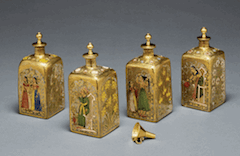
Four flasks with funnel, 1725–50. India or Europe. Brass, gold, glass, enamel; flask height: around 5⅛ in. (12.8 cm). Collection of the Corning Museum of Glass, Corning, NY, 2002.1.1.
